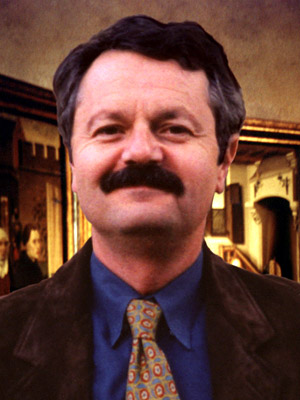Dr. Charles Falco

Have you ever painted a realistic portrait or made a still life drawing? If so, you understand what a challenge it is to render 3-Dimensional space onto a 2-Dimensional surface. Drawing a picture is a creative endeavor requiring specific skills and, until recently, it was widely believed that the great artists of the Renaissance relied on such talent alone.
However, in 2000, the renowned British-American artist, David Hockney, collaborating with the optical scientist Dr. Charles Falco, discovered evidence that many Renaissance artists used optics to assist them in creating portions of the under-drawings of certain paintings. Together they demonstrated that artists of such repute as van Eyck, Holbein, and Caravaggio understood the properties of light and lenses well enough to use optical projections for their artistic practice.
Hockney and Falco met in 2000 as a result of an article published in the New Yorker magazine by the art critic Lawrence Weschler, in which Hockney described his theory that artists likely used optics much further back in art history than was previously thought. Searching for ways to quantify his theory, Hockney began collaborating with Falco and the two embarked on an intense period of interdisciplinary inquiry. What resulted was the publication of ‘The Hockney–Falco Thesis’ – a title coined by the European Science Foundation for Hockney and Falco’s papers in which they describe their findings. Remarking on their groundbreaking work together Falco says, "Each of us brought to the task different sets of skills, both of which were required, and as a result we learned a great deal from each other."
Hockney and Falco showed that artists, not scientists, were the first to use lenses and mirrors to project images, and they did so starting at the dawn of the Renaissance. Even today Falco finds many people are astonished to learn that a lens from a pair of spectacles, or that a simple magnifying mirror, is all anyone needs to project a large, color image onto a wall or canvas (to watch a video demonstration of this please visit Falco’s website: http://www.optics.arizona.edu/ssd/FAQ.html).
Dr. Charles Falco is a Fellow of the APS, IEEE and OSA. He has published more than 250 scientific manuscripts, co-edited two books, has seven U.S. patents, and has given more than 200 invited talks on his research involving various physical properties of thin film materials, at conferences and research institutions in over 20 countries. In 1998, Falco was co-recipient of an award from the International Association of Art Critics for his work as co-curator of the Solomon R. Guggenheim museum's "The Art of the Motorcycle," for which he also wrote the exhibition catalog's introductory essay and bibliography. With over 2 million visitors in New York, Chicago, Bilbao, and the Guggenheim Las Vegas, ‘The Art of the Motorcycle’ was by far the most successful exhibition of industrial design ever assembled. His collaboration with David Hockney on the use of optics by Renaissance painters has been profiled in numerous articles in the popular press, a BBC documentary and the CBS show ’60 minutes.’ Falco has given over 100 talks on this work in museums, conferences and scientific institutions on five continents, and his current research includes applying insights from this work to machine vision and computerized image analysis.









